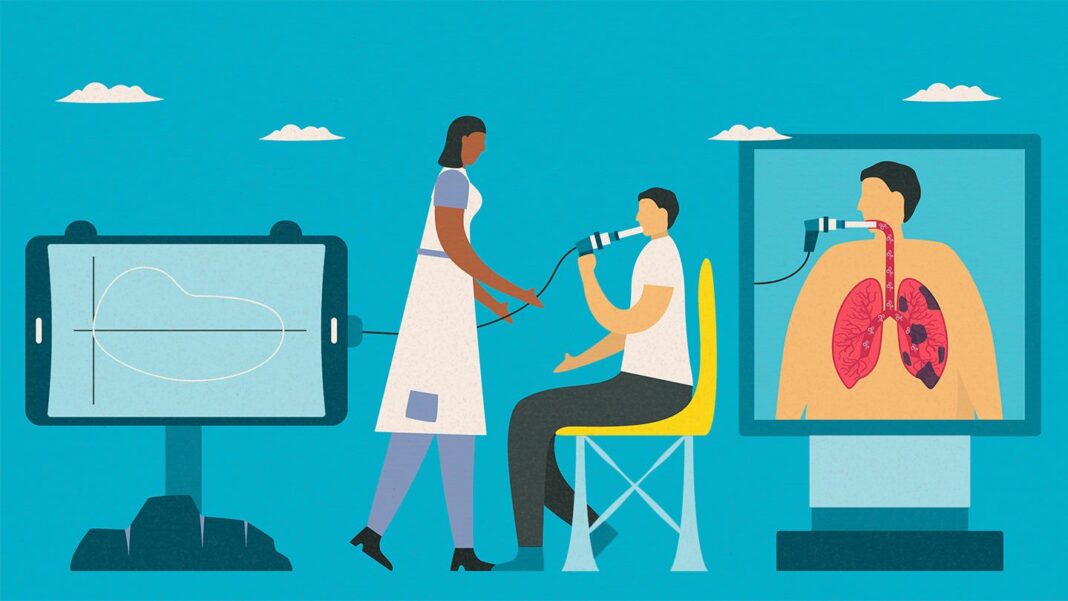There are four stages of COPD, ranging from mild to very severe.You may have also heard of a fifth stage, or “stage 0,” which is considered pre-COPD. This is a relatively new term used to describe patients of any age who present symptoms of COPD but still have normal FEV1 scores, according to the 2024 GOLD Report. These patients may still develop COPD over time.[4]GOLD Stage 1: Mild COPDAt this stage, your lung function measures at least 80 percent of predicted FEV1 value, and symptoms may be easy to dismiss.The lowest severity level of COPD is characterized by:[6]Dyspnea (breathlessness)CoughingSputum (phlegm) “During mild stage COPD, you may feel out of breath during light physical activity, like doing housework or walking up the stairs,” says Umur Hatipoglu, MD, a pulmonologist at the Cleveland Clinic in Ohio. “A hacking cough that produces mucus is also common,” he adds.The most important therapeutic option for those with mild COPD remains smoking cessation in those still smoking, says Byron Thomashow, MD, a professor of medicine at Columbia University in New York City and a cofounder of the COPD Foundation. A smoking cessation program can help you quit cigarette smoking and provide support along the way.“Diagnosing the disease early could help push smokers to stop and potentially dramatically improve their future,” Dr. Thomashow says. “Having more mild disease does not necessarily mean there are no symptoms, but with available medications and rehab programs, we can often significantly improve these symptoms.”While smoking is the most common cause of COPD, long-term exposure to lung irritants — including secondhand smoke, air pollution, and industrial dust and fumes — can also be a factor.People with mild COPD who have symptoms may be prescribed a short-acting inhaler known as a bronchodilator to use as needed.[7] These medications are delivered through an aerosol you inhale. It works by relaxing your airways, allowing you to breathe easier.It’s recommended that people with COPD get yearly flu shots and stay up-to-date on vaccines to protect against pneumonia in order to prevent complications, according to the Centers for Disease Control and Prevention (CDC).[8]Catching and treating COPD early can help slow its progression, says Diaz. “If you’re not really experiencing symptoms, the most important reason to get diagnosed at an early stage is if you’re a smoker,” he says.GOLD Stage 2: Moderate COPDAt this stage, your lung function measures 50 to 79 percent of predicted FEV1 value. With moderate COPD, shortness of breath during daily activities is more evident, and you may also experience increased coughing and mucus production, says Dr. Hatipoglu. “If you’re suffering from moderate stage COPD, you could be a good candidate for a pulmonary rehabilitation program,” he says.Pulmonary rehab can help you exercise your lungs to improve lung health and increase your ability to be more active, according to the American Lung Association.[9]This program focuses on nutrition (to achieve a healthy weight), exercise, and other strategies that can help you control your symptoms and improve your quality of life. Although pulmonary rehab can be beneficial, it’s important to know that it will not cure your condition or reverse any lung damage caused by COPD, says Hatipoglu.GOLD Stage 3: Severe COPDAt this stage, your lung function measures 30 to 49 percent of predicted FEV1 value, and you’ll likely experience symptoms beyond your respiratory system.“Once you reach severe stage COPD, your quality of life is significantly impacted,” says Hatipoglu. Symptoms can include:Shortness of breath that has become worse or occurs more oftenMore coughing or wheezingChanges in thickness or amount of mucusExtreme fatigue or weaknessFeelings of confusion or forgetfulness“Inhaled medications that will open up the airways and help a person breathe easier are often used, and for patients who get frequent exacerbations, we often prescribe inhaled corticosteroids,” says Edelman.When a person gets acute exacerbations, they are often prescribed antibiotics and several days of systemic steroids that come in the form of oral tablets, he adds.GOLD Stage 4: Very Severe COPDAt this stage, your lung function measures less than 30 percent of predicted FEV1 value. This is considered end-stage COPD, and almost everything you do causes shortness of breath and limits your mobility, says Hatipoglu.Breathing difficulties can even be life-threatening, and the lack of airflow coming into the lungs starts to affect the heart and circulatory system. “Oxygen therapy may be used in those with more severe disease,” says Thomashow. A portable oxygen tank can help improve your blood oxygen levels.In people with severe COPD who have severe and frequent symptoms, lung volume reduction surgery and even a lung transplant can sometimes be an option. To be eligible for lung volume reduction surgery, a person must be strong enough to have the surgery, participate in a pulmonary rehab program, and not be a current smoker, according to the American Lung Association.[10]Complications of COPD can include respiratory infections that make it difficult to breathe and high blood pressure in the arteries of the lung (pulmonary hypertension). People with COPD also have a higher risk of developing heart problems and lung cancer.[11]
